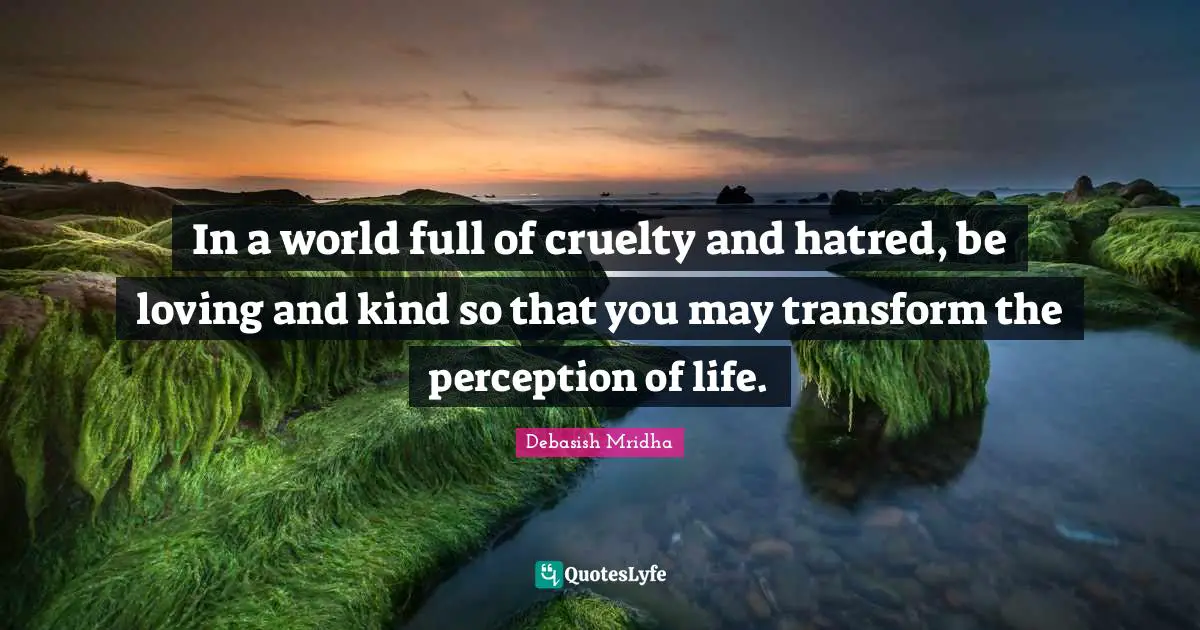In a world saturated with acts of cruelty—be it toward humans or animals—the profound question arises: Where do you hide from a world so full of cruelty? This query not only invites introspection but also dares us to confront the stark reality of our surroundings. The omnipresence of insensitivity leads to myriad challenges, both internally and externally, compelling us to seek refuge from relentless adversity.
When pondering refuge, one might initially consider physical spaces. Retreating to idyllic natural settings like tranquil forests or serene beaches may seem appealing. These spaces offer solace, a temporary respite from the cacophony of societal ills. Nature emanates an inherent healing quality, fostering a reconnection with self and stripping away the layers of chaos that urban living fosters. However, this leads to an enchanting contradiction; as we seek peace in nature, we concurrently witness the rampant exploitation of animal habitats. Deforestation, poaching, and pollution are stark reminders that cruelty knows no boundaries, encroaching even upon our most sought-after sanctuaries.
Yet, merely absconding to nature does not adequately address the core issue. It raises an essential question: How do we perpetuate silence in the face of atrocities? Many find themselves grappling with the emotional weight of the suffering they witness. This cognitive dissonance can lead individuals to withdraw into their own perceived safety, erecting emotional barriers that prevent engagement with pressing global crises. This withdrawal is understandable but problematic. If everyone turns inward, we risk fostering an echo chamber of apathy.
To navigate this complexity, it becomes necessary to cultivate a proactive disposition. Instead of seeking merely to hide, individuals could consider how to emerge as agents of change within their communities. This transformational approach begins with education. Knowledge empowers individuals to not only recognize but also to challenge systemic cruelty. Schools, media, and local organizations serve as crucial platforms for disseminating information about animal welfare, ethical treatment, and policy advocacy. Grassroots movements exemplify the power of collective action, demonstrating how individuals banding together can foster significant change, combating cruelty through awareness campaigns and outreach initiatives.
Moreover, social media provides a potent vehicle for activism. Platforms like Twitter, Instagram, and Facebook serve not only as forums for sharing individual stories and experiences but also as catalysts for global movements. As people highlight injustices and raise awareness about animal cruelty (from factory farming practices to puppy mills), the resultant viral nature of such information can galvanize communities to take action. Can a simple tweet incite a revolution? The answer lies within the collective will of those who refuse to turn away.
However, the challenge remains: can we sustain this momentum? The incessant barrage of heart-wrenching narratives can lead to compassion fatigue. An overwhelming flow of distressing content may cause individuals to retreat from activism altogether. Strategies to combat this fatigue involve focusing on self-care and community support. Establishing networks that share not only harrowing stories but also successes can invigorate the spirit. Highlighting recent legislative wins or successful rescues can serve as galvanizing beacons of hope. Emotional resilience is crucial; after all, a battle cannot be fought effectively if the warriors are too fatigued to engage.
Additionally, while individual action forms the backbone of change, societal norms significantly influence behavior. The acceptance—or rejection—of cruelty against animals is often informed by cultural context. Engaging with local philosopher-activists can yield fascinating insights into widespread belief systems about animal treatment. This discussion illuminates the intricate relationship between ethics, culture, and legislation. For instance, nations that enshrine animal rights into law demonstrate that normalized cruelty can, and must, be challenged through legal frameworks that protect vulnerable beings.
Turning the focus inward once more, it becomes evident that introspection is essential. Self-reflection allows individuals to assess their motivations, fears, and aspirations related to advocacy. What is it that stirs your spirit? Is it the plight of a specific species, or does a broader range of injustices resonate within your conscience? Identifying the depth of this connection can direct your efforts more fruitfully, enabling a robust commitment that revitalizes your sense of purpose.
Hence, as you navigate through a treacherous world, the question shifts: How do we redefine our relationship with cruelty? Hiding from cruelty may be tempting, but a more courageous choice invites us to face it head-on. It’s paramount to create spaces that foster dialogue, invite empathy, and amplify voices that challenge the status quo. Recognizing that cruelty diminishes us all illuminates the path forward. Instead of succumbing to despair, we can draw strength from community and collective action; that refuge exists not merely in physical spaces but within the solidarity of compassionate hearts striving for a more humane world.
Ultimately, as we dissect the harsh realities surrounding us, let us also envision an alternate narrative—one grounded in kindness and ethical considerations toward all creatures. The question is not just about where to hide; it is about where to stand in solidarity against cruelty, transforming our collective anguish into a formidable force for good.










